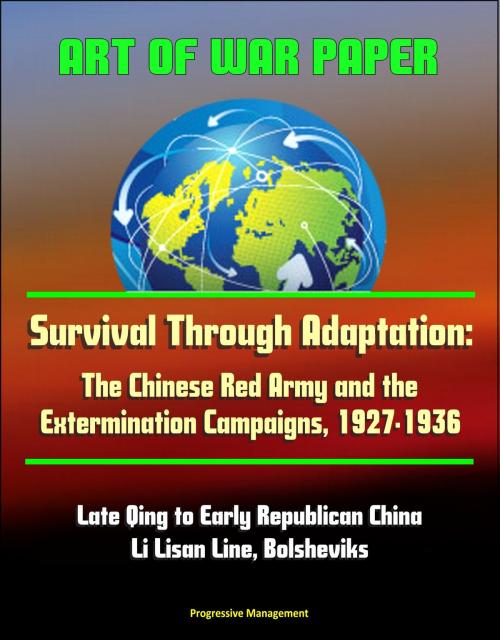Art of War Paper: Survival Through Adaptation: The Chinese Red Army and the Extermination Campaigns, 1927-1936 - Late Qing to Early Republican China, Li Lisan Line, Bolsheviks
Nonfiction, History, Asian, China| Author: | Progressive Management | ISBN: | 9781310490637 |
| Publisher: | Progressive Management | Publication: | April 7, 2014 |
| Imprint: | Smashwords Edition | Language: | English |
| Author: | Progressive Management |
| ISBN: | 9781310490637 |
| Publisher: | Progressive Management |
| Publication: | April 7, 2014 |
| Imprint: | Smashwords Edition |
| Language: | English |
China's meteoric rise to superpower status in the past forty years has sparked the interest of academics and policy makers around the world. Much scholarly research has been devoted to understanding the history, development, and modernization of China's military since the Great Reform and Opening in 1979. Documentation and historical materials from these more-recent events remain difficult for foreigners to obtain. On the other hand, historical materials from pre-1949 China have been more accessible and have led to an increase in a reexamination of historical events. With that said, there still remains a dearth of new academic research on the development of the Chinese Red Army in its first ten years of existence.
This time period is often overlooked in Chinese military history, and sometimes seen as an extension of the chaos of the early Republican China period. It is sometimes viewed as a period of guerrilla warfare, most likely influenced by the recent resurgence in the popularity of Mao Zedong's book of the same name. However, under closer examination, 1927 to 1936 was a critical time for the Chinese Red Army and its leaders. The Chinese Workers and Peasants Red Army, the precursor of today's Chinese People's Liberation Army (PLA), was created and many of the PLA's cultural traditions date back to this early period. Many of China's leaders took part in this crucible experience, influencing their perspective and outlook forever. Additionally, while guerrilla tactics were used during this time, the Chinese Red Army also adopted conventional military tactics to fight the Nationalists. It also created institutions to professionalize its forces, even while under severe constraints of war and deprivation. Using primary resource materials, classic studies of the period, and recent Chinese historical research, this study reexamines one of the most influential times in Chinese military history, the Extermination Campaigns.
Survival Through Adaptation: The Chinese Red Army and the Extermination Campaigns, 1927-1936 * Chapter 1: Introduction * Chapter 2: Late Qing to Early Republican China (1850-1926) * Chapter 3: The Chinese Red Army and the Jingang Mountains (1927-1930) * Chapter 4: Li Lisan Line and First Three Extermination Campaigns (1930-1931) * Chapter 5: Twenty-eight Bolsheviks and Final Extermination Campaigns (1932-1934) * Chapter 6: Epilogue
This study seeks to answer the following research question: How did the Chinese Red Army survive and grow from 1927 to 1936 while under constant attack from external and internal threats? In support of answering the above question, this study will also examine the following questions: 1. How did different perspectives on the same communist political ideology affect tactics and strategy? 2. How did the Chinese Red Army survive the five Extermination Campaigns? 3. How were guerrilla and conventional warfare tactics incorporated and used within the Red Army? 4. How did the Red Army create, organize, and train its own forces?
China's meteoric rise to superpower status in the past forty years has sparked the interest of academics and policy makers around the world. Much scholarly research has been devoted to understanding the history, development, and modernization of China's military since the Great Reform and Opening in 1979. Documentation and historical materials from these more-recent events remain difficult for foreigners to obtain. On the other hand, historical materials from pre-1949 China have been more accessible and have led to an increase in a reexamination of historical events. With that said, there still remains a dearth of new academic research on the development of the Chinese Red Army in its first ten years of existence.
This time period is often overlooked in Chinese military history, and sometimes seen as an extension of the chaos of the early Republican China period. It is sometimes viewed as a period of guerrilla warfare, most likely influenced by the recent resurgence in the popularity of Mao Zedong's book of the same name. However, under closer examination, 1927 to 1936 was a critical time for the Chinese Red Army and its leaders. The Chinese Workers and Peasants Red Army, the precursor of today's Chinese People's Liberation Army (PLA), was created and many of the PLA's cultural traditions date back to this early period. Many of China's leaders took part in this crucible experience, influencing their perspective and outlook forever. Additionally, while guerrilla tactics were used during this time, the Chinese Red Army also adopted conventional military tactics to fight the Nationalists. It also created institutions to professionalize its forces, even while under severe constraints of war and deprivation. Using primary resource materials, classic studies of the period, and recent Chinese historical research, this study reexamines one of the most influential times in Chinese military history, the Extermination Campaigns.
Survival Through Adaptation: The Chinese Red Army and the Extermination Campaigns, 1927-1936 * Chapter 1: Introduction * Chapter 2: Late Qing to Early Republican China (1850-1926) * Chapter 3: The Chinese Red Army and the Jingang Mountains (1927-1930) * Chapter 4: Li Lisan Line and First Three Extermination Campaigns (1930-1931) * Chapter 5: Twenty-eight Bolsheviks and Final Extermination Campaigns (1932-1934) * Chapter 6: Epilogue
This study seeks to answer the following research question: How did the Chinese Red Army survive and grow from 1927 to 1936 while under constant attack from external and internal threats? In support of answering the above question, this study will also examine the following questions: 1. How did different perspectives on the same communist political ideology affect tactics and strategy? 2. How did the Chinese Red Army survive the five Extermination Campaigns? 3. How were guerrilla and conventional warfare tactics incorporated and used within the Red Army? 4. How did the Red Army create, organize, and train its own forces?















